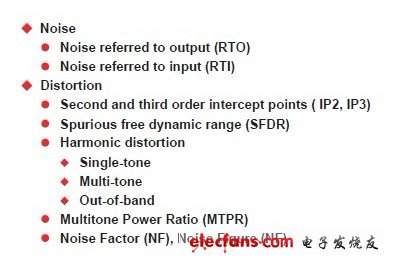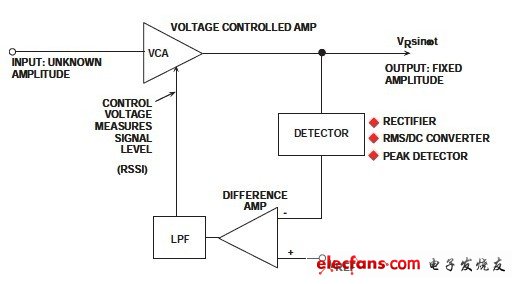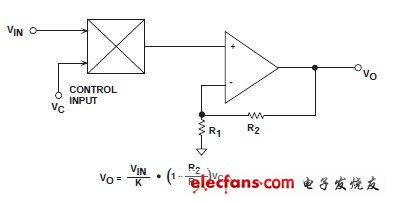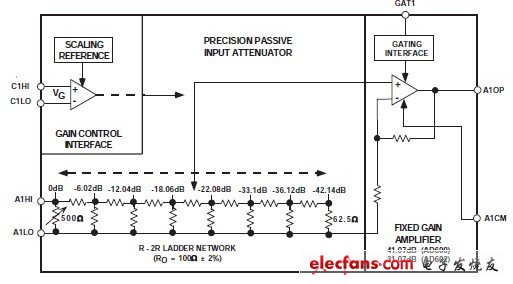This guide will focus on VGA for communication systems. Whether VGA is suitable for communication systems depends on whether these parameters meet system performance. The analog and digitally controlled VGA will be discussed.
Variable gain amplifier (VGA) wideband, low distortion variable gain amplifiers in automatic gain control (AGC) systems are widely used in communication systems. For example, automatic gain control (AGC) in a radio receiver is shown in Figure 2. In general, due to differences in propagation paths, the received energy exhibits a large dynamic range and requires dynamic range compression within the receiver.
In this case, the required information is contained in the modulation envelope (regardless of the modulation mode used), not the absolute amplitude of the carrier. For example, a 1 MHz carrier is modulated to 1 kHz with a modulation depth of 30%, and the transmitted information is the same regardless of whether the received carrier level is 0 dBm or –120 dBm. When there is a large input change, the carrier amplitude is usually adjusted to a normalized reference level using some type of automatic gain control (AGC) function in the receiver. The AGC circuit acts as a dynamic range compressor capable of responding to a signal metric (usually an amplitude average) over multiple carrier cycle intervals.
Therefore, they take time to make adjustments based on the difference in received signal levels. The peak detection method can reduce the response time required for a sudden increase in signal level, but stability can be compromised because transient noise spikes can now activate the AGC detection circuit. The concept of nonlinear filtering and "delayed AGC" is useful for optimizing AGC systems. There are many trade-offs in practice.

Figure 1: Dynamic range parameters in a communication system

Figure 2: Typical Automatic Gain Control (AGC) System
It is worth noting that an AGC loop actually has two outputs. Of course, the more obvious output is the amplitude stabilization signal. The less obvious output is the control voltage of the VCA. In fact, this voltage measures the average of the amplitude of the input signal. If the system is precisely tuned, the control voltage can be used to measure the input signal, sometimes referred to as the Received Signal Strength Indication (RSSI). Given the applicable precision VCA gain control law, a receiving system that calibrates the input signal level can be implemented using this latter point.
Voltage controlled variable gain amplifier
An analog multiplier such as the ADL5391 can be used as a variable gain amplifier, as shown in Figure 3 below. The control voltage is applied to one of the inputs and the signal is applied to the other input. With this configuration, the gain is proportional to the control voltage.

Figure 3: Using a Multiplier as a Voltage Controlled Variable Gain Amplifier
For most VCAs built with analog multipliers, the gain is linear with the control voltage in V and there is often noise. However, the required VCA combines a wide gain range with constant bandwidth and phase, low noise and large signal processing, and low distortion with low power while providing accurate, stable linear dB gain. The X-AMPTM Series can achieve these very demanding and conflicting goals with a unique and sophisticated solution for exponential amplifiers. The concept is very simple: a fixed gain amplifier is followed by a passive broadband attenuator that uses a voltage to control its attenuation in a special way (see Figure 4).

Figure 4: X-Amp block diagram
Indoor Fiber Termination Box can be supplied empty or fully loaded with adapters and pigtails. Meanwhile they are often deployed in FTTH applications for connecting feeder and distribution cables. The indoor fiber terminal box provides efficient cable connections between outside plant cables and equipment inside the buildings and communications facilities . Indoor Fiber Termination Box can be wall mounted or pole mounted and provides various accessories to avoid any unexpected damage to the fiber.
Indoor Fiber Termination Box
Indoor Fiber Termination Box,Fiber Termination Box,Fiber Optic Termination Box,Fiber Optic Box
Foclink Co., Ltd , http://www.scfiberpigtail.com